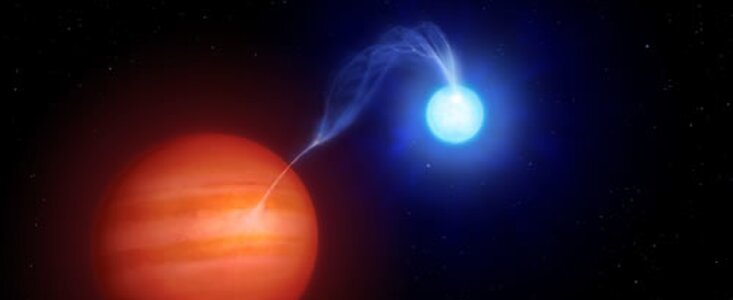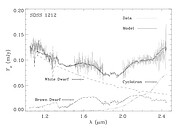Detection of Substellar Companion in Interacting Binary
19 Febrero 2008
The binary star SDSS J121209.31+013627.7, commonly known as SDSS 1212, is possibly the first interacting binary where a substellar companion has been directly detected -- via near-infrared spectroscopy with GNIRS on Gemini South. Although it was initially suspected to represent a detached, non-interacting system containing a cool, 10,000 K, magnetic white dwarf plus a brown dwarf companion, this new study favors the interpretation that the pair represent a magnetic cataclysmic variable (called a polar for the highly polarized light emitted by the mass-transferred material falling in a magnetic field) with a substellar donor in a quiescent (non-eruptive) state.
The research team, led by Jay Farihi (Gemini Observatory/University of Leicester) and including Matt Burleigh (University of Leicester) and Don Hoard (Spitzer Science Center) obtained spectroscopic data from 1-2.5 microns, which was only possible with Gemini/GNIRS due to the intrinsic faintness of this system and the fact that the light emitted changes on approximately 90 minute timescales. Gemini's great light collecting area and the simultaneous wavelength coverage of GNIRS (in cross-dispersed mode) enabled the team to gather enough light, simultaneously, at all the necessary wavelengths.
The team's most successful model includes; a cool white dwarf component, a brown dwarf component, and a cyclotron radiation component representing the infalling material from the substellar donor that is caught in the magnetic field of the white dwarf. The data, particularly the middle region of the spectrum (the H-band), are consistent with the first direct detection of a substellar object in such a system. More excitingly, the substellar donor may be of spectral type T, a class which represents methane-bearing brown dwarfs, none of which have ever been detected associated with any type of white dwarf, including non-interacting systems.
However, the donor star in this system is unlikely to have been 'born' substellar and cooled to near T dwarf temperatures (about 1300 K and below) over billions of years. Rather, it has evolved and lost internal energy via mass transfer onto the white dwarf, become smaller and colder as it has been whittled down to about 60 Jupiter masses. The donor could end up as a planetary mass object before the mass transfer turns off, or it may become entirely cannibalized by the white dwarf; the fates of these cataclysmic variables are somewhat uncertain.
Enlaces
- A Near-Infrared Spectroscopic Study of the Accreting Magnetic White Dwarf SDSS J121209.31+013627.7 and Its Substellar Companion, Farihi, J.; Burleigh, M. R.; Hoard, D. W., The Astrophysical Journal, Volume 674, issue 1, pp. 421-430.



